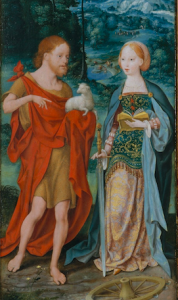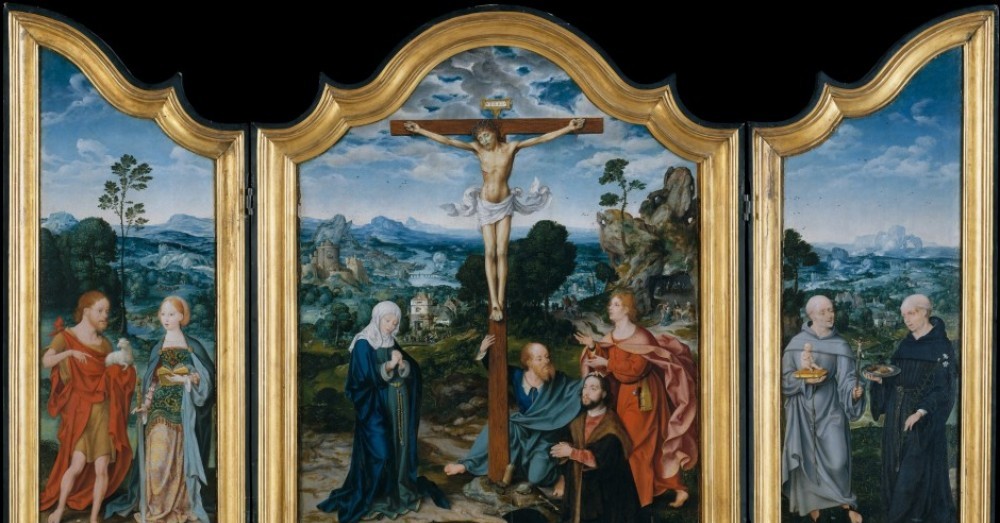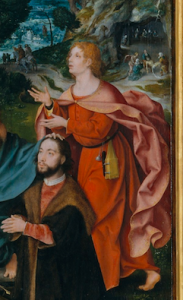
The Crucifixion with Saints and a Donor, ca. 1520. Joos van Cleve (Netherlandish, ca. 1485–1540/41) and a collaborator. Oil on wood. Bequest of George Blumenthal, 1941. The Metropolitan Museum of Art.
This triptych altarpiece in the Northern Renaissance style/tradition references the crucifixion of Christ in all three of its panels. According to the Metropolitan Museum of Art, the center panel depicts, in addition to Christ: the Virgin Mary on the left; St. Peter in a blue cloak, holding the cross with one hand and touching the head of the kneeling patron with the other; and St. John the Evangelist on the right in a red cloak. The left wing depicts John the Baptist in a red cloak, carrying the lamb of Christ. With him is St. Catherine. The right wing features two Italian saints, alluding to the role of van Cleve’s Italian patrons.

John the Baptist wears a red cloak and carries a lamb, which is symbolic of Christ’s role as the sacrificial lamb of God
One main contrast is the type of clothes worn by the St. Johns and the symbolic significance of them. The two Johns are at once linked together through the similar color of their garments, but they wear different types of clothing. St. John the Baptist, who is an anachronistic element, because he was dead at the time of the crucifixion, wears a simple cloak, tying him directly to the role he was playing in the
Bible as a prophet. Of this role, Hamburger states “[a]s a prophet, the Baptist […] did not see beyond the threshold of the promised land,” and the statement describes the Baptist’s role as the one foreseeing Christ, not the salvation (65). This means that van Cleve might have wanted to use the Baptist’s clothing to allude to the Incarnation; it is in the humble clothing of the lone prophet that John baptizes
Christ, and fulfills the Incarnation. This is different from St. John the Evangelist, who wears a decorated cloak, as well as a robe and a belt. This is not how St. John the Apostle would have been dressed. Instead of being dressed like the Baptist, the Apostle is dressed as a member of the clergy. Hamburger states that John indeed sometimes appears in “the primary role as a priest” (71). This means that, as opposed to the Baptist, the Apostle’s clothing points forward to the resurrection and the birth of the church. This would be eschatological, as John as a priest would serve a main role in preparing for judgment: to take confessions and distribute the body of Christ. This contrast helps van Cleve to illustrate the whole course of salvation in his
altarpiece, instead of just the crucifixion.
The symbols carried by the two Johns help tie their significance together. John the Baptist carries only one symbol: the lamb. This symbol also offers the strongest evidence that the figure is indeed John the Baptist, as he refers to Christ as the Lamb of God in the Gospel of St. John. The Baptist is pointing at the lamb, and van Cleve is emphasizing the importance of the sacrifice of Christ, another eschatological element. This idea is further emphasized by the Baptist’s contrapposto, leaning slightly towards Christ, tying the lamb and Christ together. The lamb is also very important in linking the Baptist to the Evangelist; John the Evangelist has a book in his belt, clearly the Bible, in which he wrote two chapters. Hamburger states:
“Linked to and through the lamb – the Baptist’s attribute and the subject of the Evangelist’s apocalyptic vision – the two St. Johns formed, together with the sacrificial offering, a trio to which was attached both eschatological and eucharistic
significance” (66).
This is exactly what happens in van Cleve’s altarpiece, where the presence of both the St. Johns contributes to the istoria. The story is not simply the crucifixion of Jesus Christ, but the whole story of salvation, from the foreseeing of Christ, through his baptism to his death and resurrection. John the Baptist is pointing at the lamb, predicting Christ and the Eucharist, and the Evangelist is making a gesture towards Christ on the cross, pointing towards the death and ressurection. In the altarpiece, Joos Van Cleve takes advantage of the dynamics Hamburger refers to as “contrast and contemplementarity” in order to enhance the istoria and the main eschatological message (65).

